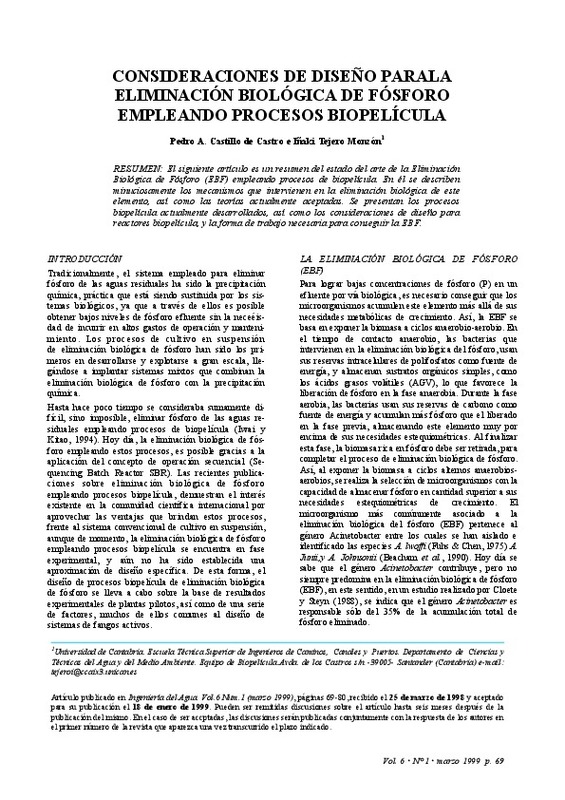Arun, V.; Mino, T. y Matsuo, T. (1988). Biological Mechanism of Acetate uptake mediated by Carbohydrate Consumption in excess Phosphorus Removal Systems. Wat. Res. 22 (5), pp. 565-570.
Barnard, J.L. (1984). Activated primary tanks for phosphate removal. Water SA 10 (3), pp. 121-126.
Beacham, A.M.; Seviour, R.J.; Lindrea, K.C. y Livinston, Y. (1990). Genospecies diversity of Acinetobacter isolates obtained from a Biological Nutrient Removal pilot plant of a modified UCT configuration. Wat. Res., 24 (1), pp. 23-29.
[+]
Arun, V.; Mino, T. y Matsuo, T. (1988). Biological Mechanism of Acetate uptake mediated by Carbohydrate Consumption in excess Phosphorus Removal Systems. Wat. Res. 22 (5), pp. 565-570.
Barnard, J.L. (1984). Activated primary tanks for phosphate removal. Water SA 10 (3), pp. 121-126.
Beacham, A.M.; Seviour, R.J.; Lindrea, K.C. y Livinston, Y. (1990). Genospecies diversity of Acinetobacter isolates obtained from a Biological Nutrient Removal pilot plant of a modified UCT configuration. Wat. Res., 24 (1), pp. 23-29.
Belia, E. y Smith, P.G. (1997). The bioaugmentation of Sequencing Batch Reactor sludges for Biological Phosphorus Removal. Wat. Sci. Tech., 35 (1), pp. 19-26.
Bowker, R. y Stensel, H.D. (1990). Phosphorus Removal from Wastewaters. Pollution Technology Review Nº 189, Nowes Data Corporation, Park Ridge, New Jersey, U.S.A.
Cloete, T. E. y Steyn, P. L. (1988). The Role of Acinetobacter as a Phosphorus Removing Agent in Activated Sludge. Wat. Res. 22(8), pp. 971-976.
Comeau, P.; Day, M; Thomas, V. (1987). Dynamics of carbon reserves in biological dephosphatation of wastewaters. Rome, 1987. Pergamon Press, Oxford.
Comeau, Y.; Hall, K.H.; Hancock, R.E.W.; Olkham, W.K. (1986). Biochemical Model for Enhanced Biological Phosphate Removal. Water Research. 20(12).
Doria-Serrano, M.C.; González-Martínez, S. y Hernández-Esparza, M. (1992). Wat. Sci. Tech., 26, 2245-2248.
Eastman, J.A. y Ferguson, J.F. (1981). Solubilization of particulate organic carbon during the acid phase oj anaerobic digestion. Journal WPCF 53 (3), pp. 352-366.
Fuhs, G.W. y Chen, M. (1975) Microbiological basis of phosphate removal in the Activated Sludge Process for the Treatment of Wastewater. Microbial Ecol. 2, pp.119-138.
Garzón-Zuñiga, M.A. y González-Martínez, S. (1996) Biological Phosphate and Nitrogen Removal in a Biofilm Sequencing Batch Reactor. Wat.Sci.Tech. 34 (1-2), pp. 293-301.
Goncalves, F.R. y Rogalla, F. (1992). Biological phosphorus removal in fixed films reactors. Wat. Sci. Tech. 25(12), pp. 165-174.
Goncalves, F.R.; Nogueira, F.N.; LeGrand, L. y Rogalla, F. (1994). Nitrogen and biological phosphorus removal in submerged biofilters. Wat. Sci. Tech. 30(11), pp. 1-12.
Goenestijn, J.W. y Deinema, M.H. (1985). Effects of Cultural Conditions on Phosphate Accumulation and Release by Acinetobacter Strain 210A. Proceedings of the Int. Conference, Management Strategies for Phosphorus in the Environment. Lisboa, Portugal, 1-4 julio.
González-Martinez, S. y Wilderer, P. (1991). Phosphate removal in a biofilm reactor. Wat. Sci. Tech. 23, pp. 1511-1521.
Henze, M.; Gujer, W.; Mino, T.; Matsuo, T.; Wentzel, M.C. y Marais, G.vR. (1995). Activated Sludge Model No 2. IAWQ Task Group on Mathematical Modelling for Design and Operation of Biological Wastewater Treatment Processes, International Association on Water Quality, 32 pages, ISBN 1-900222-00-0.
Iwai, S. y Kitao, T. (1994). Wastewater Treatment with Microbial Films. Technomic Publishing Company, Inc., 851 New Holland Ave., Box 3535, Lancaster, Penn., USA.
Johansson, P; Carlsson, H. y Jönsson, K. (1996). Modelling of the anaerobic reactor in a Biological Phosphate removal process. Wat. Sci. Tech. 34 (1-2), pp 49-55.
Kerrn-Jespersen, J.P y Henze, M. (1993). Biological Phosphorus uptake under Anoxic and Aerobic Conditions. Wat. Res. 27 (4). pp. 617-624.
Kerrn-Jespersen, J.P.; Henze, M. y Strube. R. (1994). Biological phosphorus release and uptake under alternating anaerobic and anoxic fixed-film reactor. Wat. Res. 28, pp. 1253-1255.
Liu, W-T.; Mino, T.; Matsuo. T. y Nakamura. K. (1996). Biological Phosphorus Removal Process: Effect of pH on Anaerobic substrate metabolism. Wat. Sci. Tech.,34 (1-2), pp. 25-32.
Marais, G.v.R.; Loewenthal, R.E. y Siebritz, I. (1983). Observations suporign phosphate removal by biological excess uptake. Wat. Sci. Tech. 15(3 4), pp. 15-41.
Muñoz-Colunga, A. y González-Martínez. S. (1996). Effects of Population Displacements on Biological Phosphorus Removal in a Biofilm SBR.Wat.Sci.Tech. 34 (1-2), pp. 303-313.
Nagashima, M. et al. (1979). Nitrification Denitrification Recycling System for Nitrogen and Phosphorus Removal from Fermentation WastewaterFermentation Tehcnology. 57(2).
Rabinowitz, B. y Oldham, W.K. (1986). Excess biological phosphorus removal in the activated sludge process using primary sludge fermentation. Can. J. Civ. Eng. 13, pp. 345-351.
Randal, C.; Barnard, J.; Stensel, HD. (1992). Desing and Retrofit of Wastewater Treatment Plants for Biological Nutrient Removal. Technomic Publishing Company Inc., ISNB 87762-922-6
Rovatti, M.; Nicolella, C.; Converti, A.; Chicliazza. R. y Di Felice, R. (1995). Phosphorus removal in fludized bed biological reactor (FBBR). Wat. Res. 29(12), pp. 2627-2634.
Ruiz-Treviño, F.A.; González-Martinez, S.; Doria-Serrano, C. y Hernández-Esparza, M. (1992). Phosphorus release kinetics in biofilm reactors. Wat. Sci. Tech. 26, 567-576.
Sedlak, R. (1991). Phosphorus and Nitrogen Removal from Municipal Wastewater: Principles and practice. 2° Ed., Richard I. Sedlak Editions. ISBN 0-87371-683-3
Skalsky, D.S. y Daigger, G.T. (1995). Wastewater solids fermentation for volatile acid production and enhanced biological phosphorus removal. Water Environment Research 67 (2), pp. 230-237.
Tchobanoglous, G. y Burton, F.L. (1991). Wastewater Engineering: Treatment, Disposal and Reuse. Metcalf y Eddy, 3ª Edition, 1991.
Tracy, K.D. y Flammino, A. (1985). Kinetics of Biological Phosphorus removal. 58th Annual Conference WPCF, Kansas City, Missouri
USEPA (1987). Design Manual. Phosphorus Removal. EPA/625/1-87/001, September, 1987.
WEF y ASCE (1992). Design of Municipal Wastewater Treatment Plants: Volumes I and II. WEF Manual of Practice N° 8; ASCE Manual and Report on Engineering Practice N° 76.
Wentzel, M.C.; Ekama, G.A. y Marais, G.v.R. (1992). Processes and Modelling of Nitrification Denitrification Biological Excess phosphorus removal system: A review. Wat. Sci. Tech. 25 (6), 59-82.
Wentzel, M.C.; Lötter, L.H.; Loewnthal, R.E. y Marais. G.v.R. (1986). Metabolic Behavior of Acinetobacter spp. in Enhanced Biological Phosphorus Removal: A Biochemical Model. Water SA. 12 (4), 209-224.
Wentzel, M.C.; Lötter, L.H.; Ekama. G.A.: Loewenthal. R.E. y Marais, G.v.R. (1991). Evaluation of Biochemical Models for Biological Excess Phosphorus Removal. Wat.Sci.Tech., 23 (Kyoto), pp. 567-576.
Wentzel, M.C.; Dold, P.L.; Ekama, G.A. y Marais, G.v.G. (1985). Kinetics of biological phosphorus release. Wat. Sci. Tech., 17, pp. 57-71.
[-]








